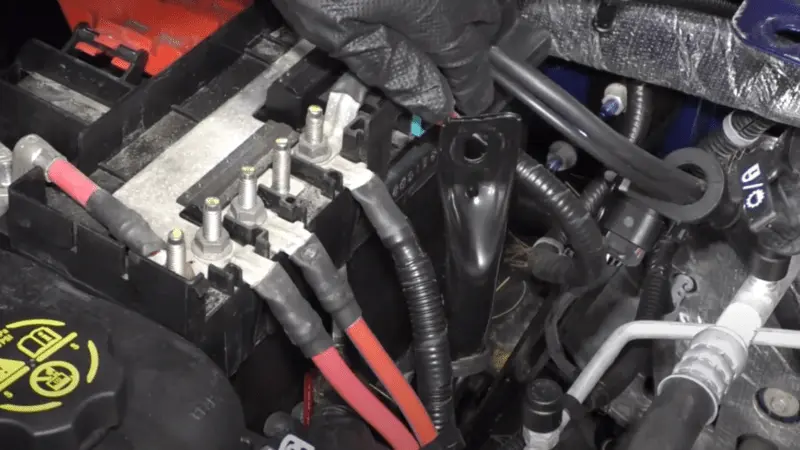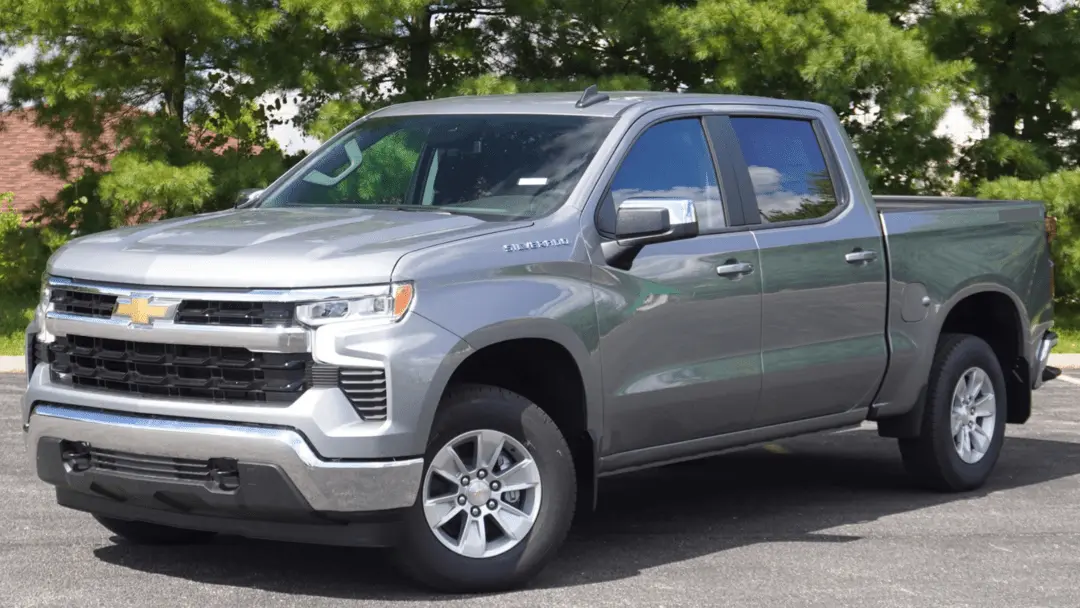You’ve just replaced the battery in your Chevy Silverado, expecting it to roar to life with renewed vigor. But to your dismay, the engine remains silent, defying your attempts to start it. The frustration of a truck that won’t budge after investing in a new battery can be maddening.
But why, generally, does the Chevy Silverado won’t start after new battery? A Chevy Silverado may not start after a new battery due to underlying issues such as a malfunctioning ignition system, faulty spark plugs, or problems with the fuel or electrical systems. Proper diagnosis is essential for a solution.
This blog post will deeply explain the perplexing issue many Chevy Silverado owners encounter. We understand your need for answers and practical solutions.
Contents
- 1 7 Reasons & Solutions Of Chevy Silverado Won’t Start After New Battery
- 2 Common Starting Myths of Chevy Silverado
- 2.1 Myth 1: A New Battery Always Fixes Starting Issues
- 2.2 Myth 2: Jumpstarting Fixes All Starting Problems
- 2.3 Myth 3: Letting the Engine Idle Warms It Up
- 2.4 Myth 4: Thumping the Gas Pedal Helps Start a Flooded Engine
- 2.5 Myth 5: Tap the Starter Motor to Make It Work
- 2.6 Myth 6: You Can Push-Start an Automatic Transmission
- 2.7 Myth 7: Starting Fluid Is a Universal Fix
- 3 Tips to Properly Maintain Your Chevy Silverado
- 4 Frequently Asked Questions
- 4.1 1. I Recently Replaced My Silverado’s Battery, But It Still Won’t Start. What Could Be The Problem?
- 4.2 2. Why Does My Silverado Crank But Not Start After Installing A New Battery?
- 4.3 3. What If My Silverado Won’t Start When The Engine Is Hot, Even With A New Battery?
- 4.4 4. Can A Weak Battery Cause Starting Problems Even If It’s New?
- 4.5 5. Why Is Jumpstarting Only Sometimes A Permanent Solution For Starting Issues?
- 4.6 6. Is It True That Letting The Engine Idle For A Long Time Warms It Up And Improves Starting?
- 5 Final Words
7 Reasons & Solutions Of Chevy Silverado Won’t Start After New Battery

#1-Starter System Issues
Reason
When your Chevy Silverado doesn’t respond when you turn the key in the ignition, it’s likely due to problems in the starter system. A malfunctioning starter, poor battery connections, or a broken solenoid could cause this.
Solution
- Check Battery Connections: Start by inspecting the battery terminals. Make sure they are clean and tightly secured. Corroded or loose connections can prevent the flow of electrical current.
- Test the Starter: If the battery connections are in good condition, testing the starter itself is important. This can be done by turning the key while listening for a clicking sound from the starter. If you hear a click, the starter might need replacement, but the engine doesn’t turn over.
- Inspect the Solenoid: Examine the solenoid responsible for engaging the starter. If it’s broken, it should be replaced. Ensure all wires connected to the solenoid are properly secured.
- Preventative Measure: Ensure the parking brake is disengaged and the gear lever is set correctly. Sometimes, the engine will only turn over if the vehicle thinks it’s in a safe starting condition.
#2- Faulty Alternator
Reason
Even with a new battery, your Chevy Silverado may still refuse to start if the alternator is faulty. The alternator is responsible for charging the battery while the vehicle is running. If it fails, the battery will not stay charged, leading to a rapid discharge and difficulty starting the engine.
Solution
- Test the Alternator: You can perform a simple test to confirm if the alternator is the issue. While the engine is running, use a multimeter to measure the voltage across the battery terminals. It should read around 13-14 volts. If the voltage is significantly lower or dropping, the alternator is likely failing.
- Replace the Alternator: If the alternator is indeed faulty, it must be replaced. This is a more involved repair and may require professional assistance. Ensure the new alternator is correctly installed and the drive belt is properly tensioned.
- Preventative Measure: Regularly inspect your vehicle’s electrical system to catch alternator issues early. Look for warning signs like dimming headlights or a battery warning light on the dashboard.
#3- Engine Cranks but Doesn’t Start:
Reason
When you turn the key and hear the engine cranking, but the vehicle fails to start, it indicates an issue with the ignition system. Several factors could be responsible, including malfunctioning spark plugs, a faulty ignition coil, low battery voltage, or distributor problems.
Solutions
- Inspect Spark Plugs: Begin by examining the spark plugs. If they appear worn or damaged, replace them. Worn-out spark plugs can inhibit proper ignition, preventing the engine from starting. Ensure you use your Silverado’s engine’s recommended spark plug type and gap settings.
- Check Ignition Coil: Test the ignition coil’s functionality using an ohmmeter or a diagnostic tool. Replacing it can restore proper spark and ignition if it’s found to be faulty.
- Verify Battery Health: Even though you’ve installed a new battery, confirm that it’s maintaining an adequate charge. Low voltage can hinder the ignition system’s performance. Recharge or replace the battery if necessary.
- Examine the Distributor: If your Silverado has a distributor, inspect it for signs of wear or damage. Distributor issues can disrupt the timing of spark delivery, leading to starting problems. Replace or repair the distributor as needed.
- Preventative Measure: Regularly replace spark plugs and perform routine maintenance on the ignition system to prevent future starting issues.
#4- The Starter Cranks, but the Engine Doesn’t Turn Over
Reason
In cases where the starter engages, but the engine remains stationary, it suggests a problem with the starting gear engagement. This could result from the starting pinion getting stuck or damaged, preventing proper meshing with the engine’s flywheel.
Solutions
- Inspect and Clean Starting Pinion: If the issue is a sticking pinion, you can often resolve it by cleaning and lubricating the starting gear mechanism. Ensure it moves freely and meshes correctly with the flywheel.
- Check for Damaged Gear: In rare instances, you may discover that the starting gear is broken or the gear’s teeth are worn out. You must replace the starting gear to enable proper engine cranking in such cases.
- Preventative Measure: Regularly lubricate and inspect the starting gear mechanism as part of your vehicle maintenance routine to prevent it from becoming stuck or damaged.
#5- Ignition System Problems:
Reason
When your Chevy Silverado doesn’t start after a new battery, it could be due to issues in the ignition system. If you turn the key and there’s no response or just a slow cranking sound, examining the ignition system is essential.
Solution
- Check Spark Plugs: Worn or faulty spark plugs can prevent the engine from starting effectively. Examine the spark plugs for wear; if they appear damaged or too old, replace them with new ones.
- Inspect Ignition Coil: The ignition coil generates the spark needed for combustion. If it’s malfunctioning, it can lead to starting problems. Use a diagnostic tool to check the ignition coil’s functionality and replace it if necessary.
- Examine Distributor Cap and Wires: Over time, the distributor cap and spark plug wires can wear out, affecting the quality of the spark. Inspect these components for damage or wear and replace them if needed.
- Preventative Measure: Regularly replace spark plugs and perform routine maintenance on the ignition system to prevent future starting issues.
#6- Fuel System Issues

Reason
If your Silverado won’t start or has trouble starting, it might be related to the fuel system. Both insufficient fuel delivery and flooding can be problematic.
Solution
- Check Fuel Delivery: Ensure the fuel pump is working correctly and there are no clogs or obstructions in the fuel lines. Low fuel pressure can impede starting.
- Address Flooding: If you smell gasoline when attempting to start the car, it could indicate flooding, where excess fuel prevents ignition. Wait a few minutes to allow the excess fuel to evaporate, then try starting the engine again.
- Preventative Measure: Regularly inspect the fuel system for clogs or leaks and maintain the pump to ensure proper fuel delivery.
RELATED: How to Jump Fuel Pump Relay on Chevy Truck
#7- Electrical System Troubles:
Reason
Electrical issues can also lead to starting problems. If you encounter inconsistent starting, especially when it’s hot outside, the electrical system might be the culprit.
Solution
- Examine Electrical Connections: Inspect all electrical connections, including the battery terminals, starter connections, and ground connections. Loose or corroded connections can disrupt the electrical flow.
- Check Starter: If the starter is clicking but not turning the engine over, it may indicate a problem with the starter solenoid or motor. Test the starter’s functionality and replace it if needed.
- Preventative Measure: Inspect and maintain electrical connections and components to prevent starting issues.
Common Starting Myths of Chevy Silverado
When starting issues with your Chevy Silverado, some common myths and misconceptions can lead to confusion and incorrect troubleshooting. Let’s debunk these false beliefs to help you better understand and address starting problems:
Myth 1: A New Battery Always Fixes Starting Issues
While a weak or old battery can indeed cause starting problems, simply installing a new battery doesn’t guarantee a solution. Other components, like spark plugs, the ignition system, or the fuel system, may also be at fault. It’s essential to diagnose the specific issue before replacing the battery blindly.
Myth 2: Jumpstarting Fixes All Starting Problems
Jumpstarting can help if the battery is the primary issue, such as a dead battery due to lights left on. However, if the underlying problem lies in the ignition, fuel system, or electrical connections, jumpstarting will only provide a temporary solution. It’s a temporary fix that may get you going but doesn’t address the root cause.
Myth 3: Letting the Engine Idle Warms It Up
Modern vehicles, including the Chevy Silverado, do not require extensive idling to warm up the engine. Idling for extended periods is wasteful and can harm the environment. It’s better to start the engine and drive gently to warm it up efficiently while conserving fuel.
Myth 4: Thumping the Gas Pedal Helps Start a Flooded Engine
Thumping the gas pedal repeatedly when dealing with a flooded engine worsens the problem. It doesn’t necessarily clear excess fuel and can flood the engine further. Instead, follow the manufacturer’s recommended procedure for starting a flooded engine.
Myth 5: Tap the Starter Motor to Make It Work
Some believe tapping the starter motor with a tool can temporarily fix a faulty starter. While it might work occasionally, there are more reliable and long-term solutions. A malfunctioning starter motor should be properly diagnosed and replaced by a professional mechanic.
Myth 6: You Can Push-Start an Automatic Transmission
Push-starting, also known as bump-starting, typically applies to manual transmissions. There are more suitable methods for automatic transmissions. Attempting to push-start an automatic vehicle can damage the transmission or other components.
RELATED: How to Reset Transmission Control Module Chevy Silverado
Myth 7: Starting Fluid Is a Universal Fix
Starting fluid is designed for specific applications and should not be used as a universal fix for starting issues. Using it incorrectly can lead to engine damage or even safety hazards. It’s best to consult a mechanic for proper diagnosis and solutions.
Tips to Properly Maintain Your Chevy Silverado
Here are seven crucial tips to help you properly maintain your Chevy Silverado:

1. Follow the Maintenance Schedule
Consult your vehicle’s owner’s manual for the manufacturer’s recommended maintenance schedule. Adhering to this schedule ensures that you address critical maintenance tasks at the right intervals, such as oil changes, filter replacements, and inspections.
2. Regular Oil Changes
Changing the engine oil and oil filter on time is crucial for your Silverado’s engine health. Fresh oil keeps the engine lubricated and prevents wear and tear. Aim to change the oil according to the recommended mileage or time frame.
3. Check and Maintain Fluid Levels
Regularly inspect and top off essential fluids like coolant, transmission, brake, and power steering. Proper fluid levels are vital for properly functioning various systems in your truck.
4. Inspect and Rotate Tires
Tire maintenance is essential for safety and efficiency. Check tire pressure regularly and rotate the tires as recommended by the manufacturer. This helps ensure even tire wear, improving traction and extending tire life.
5. Brake System Care
Keep an eye on your Silverado’s brake system. Listen for squeaks or grinding noises, and have your brakes inspected if you notice any issues. Timely brake pad replacement can prevent damage to other braking components.
6. Keep the Air Filter Clean
The air filter prevents dirt and debris from entering the engine. A clogged air filter can reduce engine efficiency and performance. Replace it at regular intervals to maintain optimal fuel efficiency.
7. Address Warning Lights Promptly
If warning lights illuminate on your dashboard, don’t ignore them. These lights indicate potential issues with various vehicle systems, and addressing them promptly can prevent further damage or costly repairs.
Bonus Tip: Regular Wash and Wax
While not directly related to mechanical maintenance, keeping your Silverado clean by washing and waxing it regularly helps protect the paint and prevent rust and corrosion. This step can also enhance the vehicle’s overall appearance and resale value.
Frequently Asked Questions
1. I Recently Replaced My Silverado’s Battery, But It Still Won’t Start. What Could Be The Problem?
Even with a new battery, starting issues can persist. Check other components like the ignition system, spark plugs, and electrical connections, as these can affect the starting process.
2. Why Does My Silverado Crank But Not Start After Installing A New Battery?
Cranking without starting could be due to problems in the ignition system, such as faulty spark plugs, ignition coils, or distributor issues. Ensure these components are in good condition.
3. What If My Silverado Won’t Start When The Engine Is Hot, Even With A New Battery?
Difficulty starting when the engine is hot might be related to the air intake or electrical system. It could be due to reduced airflow, leading to vapor lock or electrical resistance due to heat. Investigate these areas for potential issues.
4. Can A Weak Battery Cause Starting Problems Even If It’s New?
Yes, a new battery can still be weak or have a low charge. It’s essential to check the battery’s voltage and ensure it’s properly charged. A weak battery may need more power to start the engine effectively.
5. Why Is Jumpstarting Only Sometimes A Permanent Solution For Starting Issues?
Jumpstarting can help in cases where the battery is the primary issue, but it won’t fix underlying problems in the ignition, fuel system, or electrical connections. It’s a temporary solution that may not address the root cause.
6. Is It True That Letting The Engine Idle For A Long Time Warms It Up And Improves Starting?
Modern vehicles like Silverados don’t require extended idling to warm up. Starting the engine and driving gently to warm it up is more efficient while conserving fuel. Excessive idling is unnecessary and wasteful.
Final Words
A Chevy Silverado refusing to start after a new battery installation can be particularly frustrating. However, armed with the knowledge shared in this blog post, you’re better prepared to tackle this issue head-on.
Remember, the starting system of your Silverado is a complex interplay of various components, and pinpointing the exact cause of the problem can sometimes require detective work. Whether it’s addressing issues in the ignition system, fuel system, or electrical connections, our goal has been to empower you with practical solutions.
Maintaining your vehicle’s reliability is not just about the joy of a smoothly running Silverado; it’s also about ensuring your safety on the road. Regular maintenance and prompt troubleshooting can go a long way in keeping your Silverado dependable and your driving experiences worry-free.

Hello, this is Wesley Shelton, currently working in a car restoration company for over 5 years. Before that, I was a worker at a small car repair shop. As I was a car freak from a young age and worked as a professional for over half a decade, I think I now know pretty much everything about every car and its parts. To establish my name as a professional and help others by sharing my knowledge, I’ve created this website, which I work on whenever I get free time. I hope you’ve enjoyed my informative blog!


